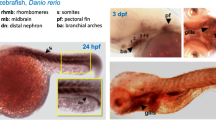Abstract
SH3 domain-binding glutamic acid-rich (SH3BGR) gene family is composed of SH3BGR, SH3BGRL, SH3BGRL2, and SH3BGRL3 which encodes a cluster of small thioredoxin-like proteins and shares a Src homology 3 (SH3) domain. However, biological functions of SH3BGR family members are largely elusive. Given that zebrafish (Danio rerio) sh3bgrl, sh3bgrl2, sh3bgrl3, and sh3bgr are evolutionally identical to their corresponding human orthologues, we analyzed the spatiotemporal expression of SH3BGR family members in zebrafish embryonic development stages by in situ hybridization. Our results revealed that except sh3bgrl, other members are all maternally expressed, especially for sh3bgrl3 that is strongly expressed from one-cell stage to juvenile fishes. In situ expression patterns of SH3BGR members are similar in the very early developmental stages, including with commonly strong expression in intestines, olfactory bulbs, and neuromasts for neural system building up. Organ-specific expressions are also demonstrated, of which sh3bgr is uniquely expressed in sarcomere, and sh3bgrl3 in liver. sh3bgrl and sh3bgrl2 are similarly expressed in intestines, notochords, and neuromasts after 12-h post-fertilization of embryos. Eventually, messenger RNAs (mRNAs) of all sh3bgr members are mainly constrained into intestines of juvenile fishes. Collectively, our study clarified the expression patterns of sh3bgr family members in diverse organogenesis in embryonic development and indicates that SH3BGR members may play predominant roles in neural system development and in maintenance of normal function of digestive organs, especially for intestine homeostasis. However, their expression patterns are varied with the development stages and organ types, suggesting that the aberrant expression of these members would result in multiple diseases.






Similar content being viewed by others
References
Collares CVA, Evangelista AF, Xavier DJ, Takahashi P, Almeida R, Macedo C et al (2013) Transcriptome meta-analysis of peripheral lymphomononuclear cells indicates that gestational diabetes is closer to type 1 diabetes than to type 2 diabetes mellitus. Mol Biol Rep 40(9):5351–5358
Egeo A, Mazzocco M, Arrigo P, Vidal-Taboada JM, Oliva R, Pirola B et al (1998) Identification and characterization of a new human gene encoding a small protein with high homology to the proline-rich region of the SH3BGR gene. Biochem Biophys Res Commun 247(2):302–306
Goljanek-Whysall K, Pais H, Rathjen T, Sweetman D, Dalmay T, Munsterberg A (2012) Regulation of multiple target genes by miR-1 and miR-206 is pivotal for C2C12 myoblast differentiation. J Cell Sci 125(Pt 15):3590–3600
Jang DG, Sim HJ, Song EK, Medina-Ruiz S, Seo JK, Park TJ (2015) A thioredoxin fold protein Sh3bgr regulates Enah and is necessary for proper sarcomere formation. Dev Biol 405(1):1–9
Majid SM, Liss AS, You M, Bose HR (2006) The suppression of SH3BGRL is important for v-Rel-mediated transformation. Oncogene 25(5):756–768
Mazzocco M, Arrigo P, Egeo A, Maffei M, Vergano A, Di Lisi R et al (2001) A novel human homologue of the SH3BGR gene encodes a small protein similar to glutaredoxin 1 of Escherichia coli. Biochem Biophys Res Commun 285(2):540–545
Mazzocco M, Maffei M, Egeo A, Vergano A, Arrigo P, Di Lisi R et al (2002) The identification of a novel human homologue of the SH3 binding glutamic acid-rich (SH3BGR) gene establishes a new family of highly conserved small proteins related to thioredoxin superfamily. Gene 291(1–2):233–239
Muñiz Lino MA, Palacios-Rodríguez Y, Rodríguez-Cuevas S, Bautista-Piña V, Marchat LA, Ruíz-García E et al (2014) Comparative proteomic profiling of triple-negative breast cancer reveals that up-regulation of RhoGDI-2 is associated to the inhibition of caspase 3 and caspase 9. J Proteome 111:198–211
Sandri C, Di Lisi R, Picard A, Argentini C, Calabria E, Myklak K et al (2004) Heart morphogenesis is not affected by overexpression of the Sh3bgr gene mapping to the Down syndrome heart critical region. Hum Genet 114(5):517–519
Scartezzini P, Egeo A, Colella S, Fumagalli P, Arrigo P, Nizetic D et al (1997) Cloning a new human gene from chromosome 21q22.3 encoding a glutamic acid-rich protein expressed in heart and skeletal muscle. Hum Genet 99(3):387–392
Wang H, Liu B, Al-Aidaroos AQ, Shi H, Li L, Guo K et al. (2015) Dual-faced SH3BGRL: oncogenic in mice, tumor suppressive in humans. Oncogene. doi:10.1038/onc.2015.391
Acknowledgments
We thank the Zebrafish Model Animal Facility, Institute of Clinical and Translational Research, Sun Yat-Sen University for providing the embryos. This study was supported by the project of Guangzhou Science Technology and Innovation Commission (No. 201510010144) and to YS, Project of International Collaboration in Science and Technology of Guangdong Province (No. 2014A050503030), and National Natural Science Foundation of China (No. 81171947) to WH.
Author information
Authors and Affiliations
Corresponding authors
Ethics declarations
Conflict of interest
The authors declare that they have no conflicting interests.
Additional information
Communicated by Matthias Hammerschmidt
Rights and permissions
About this article
Cite this article
Tong, F., Zhang, M., Guo, X. et al. Expression patterns of SH3BGR family members in zebrafish development. Dev Genes Evol 226, 287–295 (2016). https://doi.org/10.1007/s00427-016-0552-5
Received:
Accepted:
Published:
Issue Date:
DOI: https://doi.org/10.1007/s00427-016-0552-5




